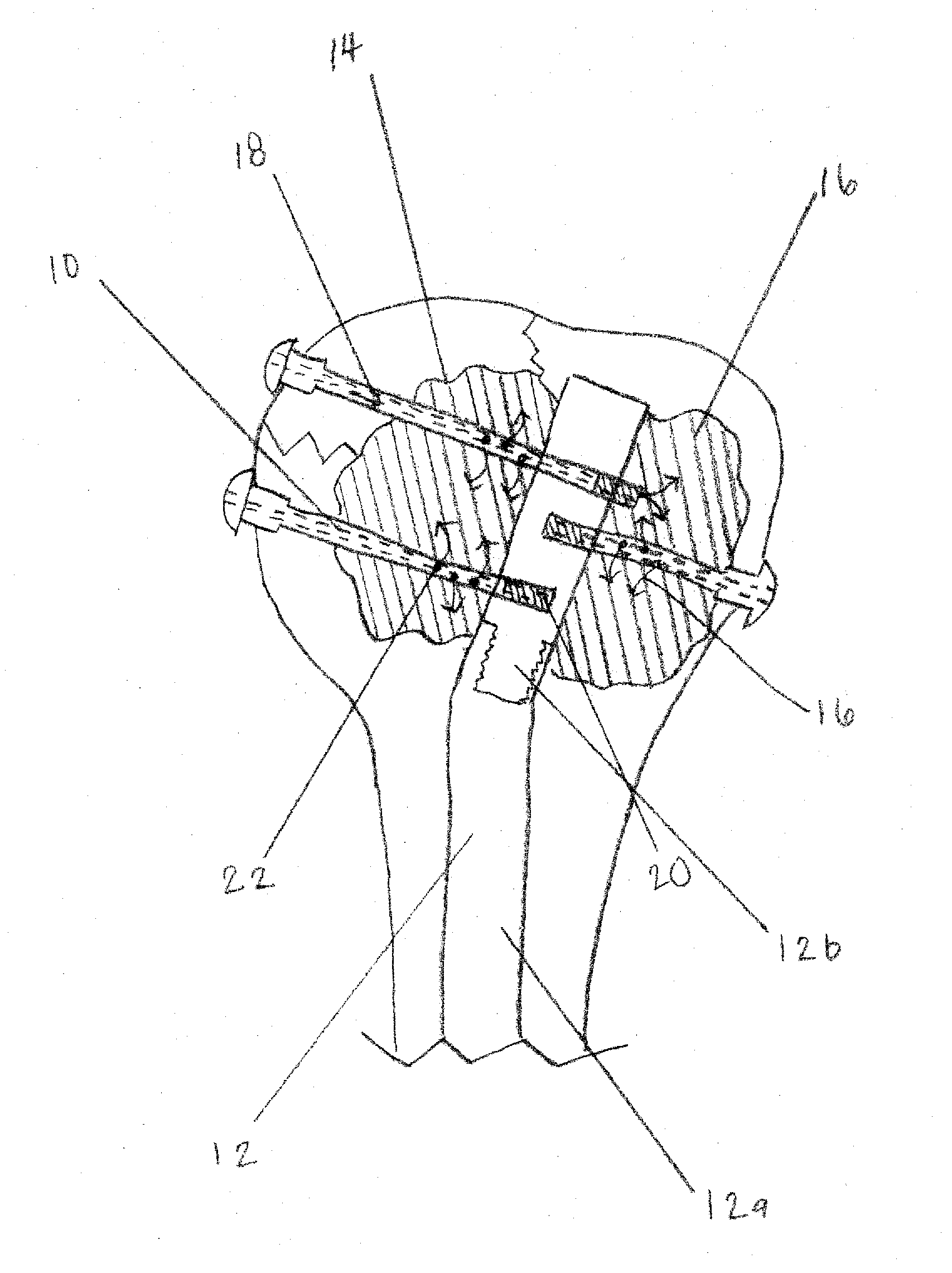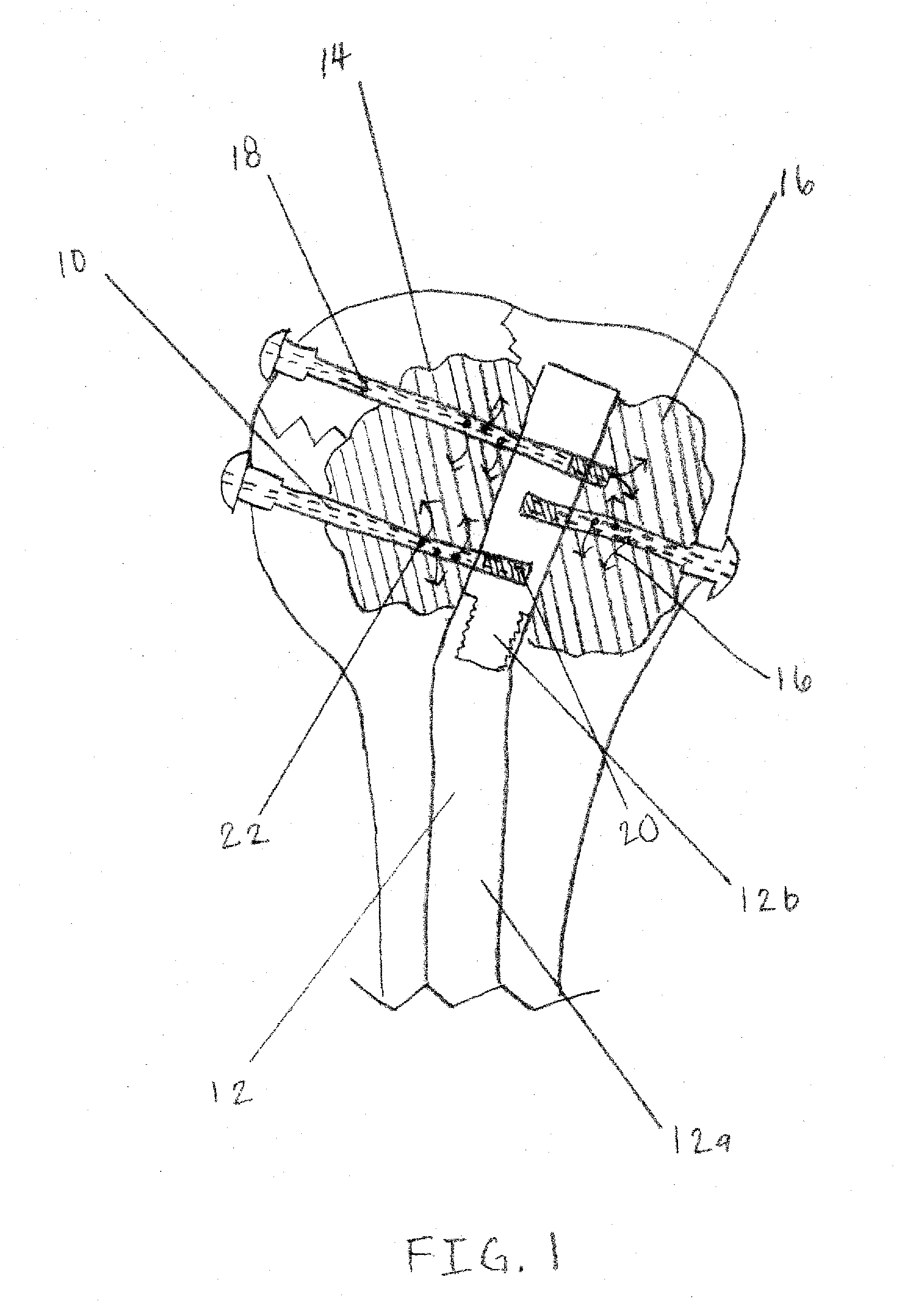Apparatus and Methods of Repairing Bone Defects
a technology of apparatus and bone defects, applied in the field of apparatus and methods for repairing bone defects, can solve the problems that no related art discloses the use of cannulated screws to introduce filling cement or glue, and achieve the effect of fortifying the structural integrity of the bon
- Summary
- Abstract
- Description
- Claims
- Application Information
AI Technical Summary
Benefits of technology
Problems solved by technology
Method used
Image
Examples
first embodiment
[0022]FIG. 1. illustrates the present invention. After an intramedullary nail 12 is installed in the proximal humerus with intraosseous void 14, one or more cannulated screws 10 are affixed to intramedullary nail 12. The intramedullary nail 12, as illustrated in FIG. 1, is an intramedullary rod having a stem member 12a and an extension member 12b. The cannulated screws 10 can be attached to extension member 12b or stem 12a. The threaded distal ends 20 of cannulated screws 10 can terminate in stem member 12a or extension member 12b, or they may pass through stem member 12a or extension member 12b to terminate inside the bone or osseous void. Further discussion of the intramedullary rod, including how stem member 12a and extension member 12b are connected, is found in U.S. Pat. No. 5,776,194, which was previously incorporated by reference in its entirety, and patents cited therein. However, it should be noted that the present invention is not limited simply to use in conjunction with ...
second embodiment
[0026]A second embodiment for treating a broken bone, such as a proximal humerus with intraosseous void 14, as illustrated in FIG. 2, uses one or more cannulated screws 10. More specifically, the one or more cannulated screws 10 contain exit slots 22 in addition to hollow longitudinal channel 18 and hollow threaded end 20. After one or more cannulated screws 10 are installed in the bone, a bioresorbable or non-bioresorbable glue or cement 16 can be injected into the proximal end of hollow longitudinal channel 18. Subsequently, the glue or cement 16 is extruded into intraosseous void 14 from hollow distal end 20 of hollow longitudinal channel 18 or exit slots 22. After curing, the one or more cannulated screws 10 are then incorporated into the cement construct, adding stability to the reconstructed humerus.
third embodiment
[0027]In the present invention, illustrated in FIG. 4, one or more cannulated screws 10 are inserted into a femur through a plate 30 affixed to the outside of the bone to secure a fracture at the femoral neck 32. At least one cannulated screw 10 slides through plate 30 and passes into femoral head 28. A bioresorbable or non-bioresorbable glue or cement 16 is deposited into the proximal end of cannulated screw 10 and through hollow longitudinal channel 18. If no osseous void or cavity exists, glue or cement 16 is extruded through exit slots 22 or hollow distal end 20 of hollow longitudinal channel 18 and subsequently interdigitates with the porous bone of femoral neck 32 or femoral head 28. If an osseous void or cavity does exist at the proximal end of the femur, glue or cement 16 is extruded through exit slots 22 or hollow distal end 20 of hollow longitudinal channel 18 and fills said osseous void or cavity. Upon curing, glue or cement 16 helps to strengthen the fixation of cannulat...
PUM
 Login to View More
Login to View More Abstract
Description
Claims
Application Information
 Login to View More
Login to View More - R&D
- Intellectual Property
- Life Sciences
- Materials
- Tech Scout
- Unparalleled Data Quality
- Higher Quality Content
- 60% Fewer Hallucinations
Browse by: Latest US Patents, China's latest patents, Technical Efficacy Thesaurus, Application Domain, Technology Topic, Popular Technical Reports.
© 2025 PatSnap. All rights reserved.Legal|Privacy policy|Modern Slavery Act Transparency Statement|Sitemap|About US| Contact US: help@patsnap.com



